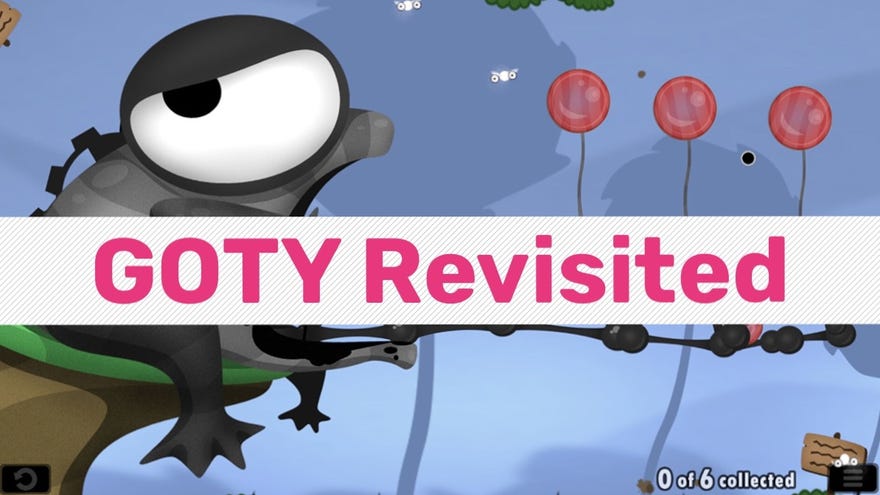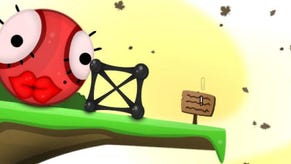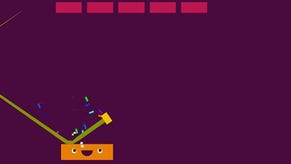RPS GOTY Revisited: 2008's World Of Goo still offers more fun than nearly any puzzle game since
Love, from the Sign Painter
Did your science teacher ever let you play around with non-Newtonian fluids? If not, my condolences. You missed out on some of the greatest fun you could have at school. I remember holding a big ball of starchy goo, balling it up and turning it over and over in my hands, marvelling at its strange rigidity. And then I'd stop playing with it, and watch with childish glee as the slop slowly seeped through my fingers, its form reacting immediately and satisfyingly to my touch.
I felt that same glee when I played Tower Of Goo Unlimited back in 2005 - the prototype that would three years later become RPS's game of the year for 2008. It was well and truly a prototype, a single level with the aim of building the highest possible tower out of sticky balls that were connected via long strands of wobbly guck. It was silly, and messy, and confusing, and marvellous, and I realised very quickly that I needed a proper game like this in my life as soon as possible.
World Of Goo, like its prototype, is a physics-based puzzle game. Each level puts you in charge of a group of remarkably cute sentient balls of goo, and your aim is to get the goo up to the pipe at the end of the level, where they'll be sucked up to safety. To get there, you need to drag and drop the goo balls so that they connect to one another, forming gooey structures such as towers, bridges, pendulums, and more. The goo's structural integrity isn't great, so a lot of the time you'll need to either build slowly, constantly shoring up the foundations of your structure, or else work very fast, stacking goo upon goo in an attempt to outpace the physics simulation's propensity to have your structures buckle and collapse under their own weight.
The game is divided into a handful of chapters, and every few levels in each chapter introduces a new type of goo ball or mechanic. There are pink helium balloon-like goo that can lift your structures to new heights. Then there are green velcro-like goo, which can be detached from their structures at will, allowing you to reform existing structures. Later on you'll find even more exotic types, like flammable goo, or goo which you can fire from point to point like an arrow. And each chapter makes good use of the steady dripfeed of new mechanics, giving you the space to play around with each one, and then posing problems which can only be solved with a proper understanding of how each Goo works.

There's also the broad strokes of a story about exploitation and corporate greed, told through sporadic seconds-long cutscenes and messages left behind for the player by a mysterious individual known as the Sign Painter. It's worth clicking on the signs when you see them, because a lot of the time they also offer hints about how to go about solving each level. But they, like the story as a whole, can easily be ignored. When I think fondly on World Of Goo, it's never about the story - it's about the fun of struggling to form the goo exactly how I want them.
It's rare for a puzzle game so physical and mouldable to have those "goodness, how clever and elegant!" moments, which are what tends to keep me playing most puzzle games. I'd much more readily expect to be met with the genius of a level-designer when solving a puzzle in games like Hexcells or Baba Is You, because the building blocks of those games are logic and rules. The building blocks of World Of Goo are, quite literally, goo. Stretchy, squeaky, adorable goo. The message of each level is less about "look how clever I am", and more about "look how much fun you can have here".
That doesn't mean the levels of World Of Goo aren't clever. Particularly in later chapters the extra mechanics force you to think in completely different and frequently fascinating ways. I'm not going to spoil every single surprise that the game has in store for new players, but I will say that the later levels where you start stacking goo blocks instead of balls are some of my favourites in the entire game. Cleverly combining the lego-like stacking of blocks with the plasticine-like stretching of goo structures makes for some really interesting puzzles, and gives 2D Boy plenty of opportunity to add more character to the game's adorable titular protagonists.

The personality that 2D Boy gives the goo is a huge part of the game's fun. It starts off as little more than an extra bit of charming silliness. But as time went on, I began to sense a powerful camaraderie between the dozens of googly-eyed goo balls in each level. I was their instructor, but they were the ones risking their lives to physically haul each other under and over deadly obstacles. Certain levels began to feel like that scene from Finding Nemo where all the hundreds of fish caught in the net learn to swim down together to avoid being reeled in. There were times when I found myself whispering words of encouragement to the goo under my breath while they stretched taut, desperately trying to keep their friends clear of the giant spinning blade of death just below. If one of them was caught by the blade, I'd wince at their pitiful little splatting sound, and immediately click one of the time-rewinding flies floating around the screen. I could bear leaving behind the heroic goo balls who helped their brethren to safety, but I couldn't abide having them die unnecessarily in the process. I cared about them far too much for that.
Let me use that mention of splatting sounds to segue into a discussion of another high point of World Of Goo: its faultless sound design and score. Lots of games shoot for that subtly satisfying style of sound design, filled with inoffensive pops and bloops and ticks that you could happily listen to all day. But very few do it as well as World Of Goo, which not only manages to make pretty much every single sound in the game deeply satisfying, but also uses those sounds to further elevate the personality and charm of the goo. There's a particular noise that the goo can make when you let go of it and it isn't attached to anything, and it's very similar to the vaguely disgruntled noise made by one of my cats whenever I pick them up unexpectedly for a cuddle. It brims my heart with joy every time I hear it.
As for the soundtrack, the only negative thing I can say about it is that it's too short. You don't have to go very far into the game before you hear the same bits of music repeated from earlier levels. That's not really a bad thing, though, because each piece is so delightful, so alive with whimsical wonder. Kyle Gabler's score for World Of Goo runs the gamut from merry and uplifting to frenetic and tense, but never loses that quirky, playful, ever-so-slightly-sinister fantasy feel.

It's at this point that I remember Katharine asked me to revisit not only World Of Goo with this write-up, but also the decision to elect it game of the year in the first place. Does it still hold up as the best game of 2008? Well, look. World Of Goo isn't one of my favourite games ever made. It's not even the game I had most fun playing in 2008. That accolade goes to the perpetually contentious Spore. I was part of the minority who considered Spore to be a good game worthy of my time - but I could see even as a 13-year-old that the entire experience was lopsided. Spore was a great big wonderful smashed pavlova of ideas, where some parts of the meringue are perfect and others have clearly collapsed under the weight of all the fruit stacked on top.
By contrast, World Of Goo is more of a perfectly formed tiramisu, with satisfyingly rounded edges and delicate, punchy layers. It feels like the essence of the original Tower Of Goo pushed to the full limits of its potential. Imagine if a World Of Goo sequel were made this year. I'm sure it would have new types of goo and lots of clever new levels, but would that make it a better game than the original? I'm not sure it would; nor am I sure a sequel will ever be needed. It's not as though the original feels dated, even 13 years later. I'm not sure I could say the same of any of the other games in our advent calendar for that year.
To me, World Of Goo feels simultaneously as though it could have been made this year, and also undeniably, quintessentially 2008. Part of that is because it's a stylised 2D puzzle game, and those don't really go out of date like a big-budget first-person-shooter might. But I think it's also because World Of Goo forms such a large part of my definition of that year. Without it, 2008 wouldn't have been nearly the year it was for games.


















